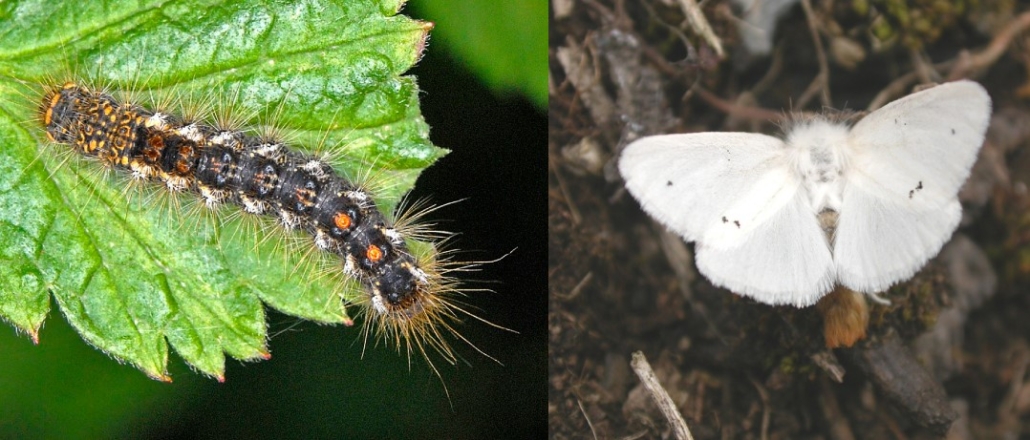GARDEN WORKS – The eleventh plague: Battle of the browntail moth and curse of the caterpillars

Browntail moth caterpillar showing the two red dots at the end of its tail that differentiates it from other hairy caterpillars (moth on right)
 by Emily Cates
by Emily Cates
Well! I had intended, amongst the hustle and bustle of a busy life and chaos in the garden, to write on the next rainy day… which doesn’t help so much with a lack of rain. Anyways, here we are for a look at one of the most annoying problems – besides ticks – that I’ve ever had to deal with outdoors. Now, what could that possibly be? You guessed it, those blasted browntail moths and their cursed caterpillars!
Unless you live under a rock, or in a cave, or in your parents’ basement, you’re probably unwillingly familiar with these cantankerous characters. If you need an introduction, call 211 or look it up on here.
If you reside in or visit central Maine this time of year from April to late June, you, too, may have the miserable experience of disagreeable symptoms as a result of direct or airborne exposure to the tiny, poisonous hairs disturbed from a living or dead caterpillar, or molted caterpillar skins. Symptoms range from slight discomfort, to itchy red bumps in the area of exposure, or to an all-out inflammation extravaganza requiring medical assistance. Symptoms can last anywhere from a few hours (if you’re lucky), or weeks (if you’re like me and not so fortunate).
Yes, folks, I too have the measly rash. (It even looks like measles!) And I’ve had it continually for the past couple months. It’s almost like my senses have become dulled to the perpetual prickling on my skin. Never before has scraping my arms and neck with a butter knife and plastering myself with clay evoked such satisfaction.
I try to look at the bright side and count myself among the folks who do not have the breathing problems associated from being around these pests. Also, I’ve resolved never again to mow the lawn under my fruit trees wearing a tank top or short sleeves. Hat and gloves are a must!
Unfortunately, the best window of opportunity to eradicate the caterpillars by destroying their nests has slammed shut. December through April is the optimal time to check the tips of your oak and fruit trees for their silky webs, cut off any you find, and chuck those into a bucket of soapy water to soak overnight. Another flush of these happens in July, so another – albeit less optimal chance to get them – might present itself. Just be sure to wear long-sleeves, a hat, and possibly a face mask when working around trees since the hairs from the current crop of caterpillars are still a problem. Hairs remain toxic for up to three years!
During the night, the moths will be attracted to and drown in a soapy mixture of apple-scented dish soap in a bucket of water. Place the bucket as close as possible under a light.
So, what to do if exposed? There are tons of tips and tricks out there as this has become a serious community crisis affecting so many folks in our area. Unfortunately, there is no official specific treatment, but home remedies may help address the itching and swelling.
Everybody is different, so it’s important to find the safest individual solution if possible. Of course, it would be advisable to contact a trusted care provider immediately if symptoms are severe – especially when there is trouble breathing, swallowing, or swelling of the mouth, tongue, or throat.
That said, here are a few suggestions from my personal experience and others’. Please share your thoughts and suggestions with us!
As soon as possible after exposure, gently wash the area with plain soap and water. Unscented, natural soaps like Dr. Bronner’s and African black soap don’t contain fragrances or other added chemicals that can compound the problem in sensitive skin.
Resist the urge to scratch with fingernails, as this can make things worse. A clean body brush or similar utensil could be more effective.
Cosmetic-grade clay may help draw out the caterpillar hairs and their toxins.
Try a cool bath with baking soda.
Witch hazel – if it’s not sold out of the stores – can really help!
Now, wouldn’t it be great if someone could train cedar waxwings to eat these caterpillars rather than berries!
Do you have a remedy or want to share your experience dealing with the browntail moth caterpillar? Email Emily at emilycates@townline.org.
Responsible journalism is hard work!
It is also expensive!
If you enjoy reading The Town Line and the good news we bring you each week, would you consider a donation to help us continue the work we’re doing?
The Town Line is a 501(c)(3) nonprofit private foundation, and all donations are tax deductible under the Internal Revenue Service code.
To help, please visit our online donation page or mail a check payable to The Town Line, PO Box 89, South China, ME 04358. Your contribution is appreciated!


Leave a Reply
Want to join the discussion?Feel free to contribute!